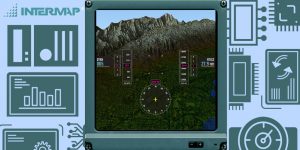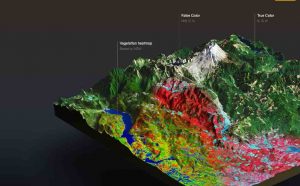
Nearmap is a leading aerial imagery and location intelligence company that captures aerial images of Australia, New Zealand, and the United States up to three to four times a year. Their imagery is used by city governments to look at areas they protect, insurance companies to process claims in the event of a natural disaster, and commercial agencies to make smart decisions when planning a building site.
Agresta states, “Nearmap is unique in its capture of aerial imagery, focusing on currency, consistency, coverage, and ease of access. Our imagery is published within days of capture, with 24/7 access through a web app, API, or third-party integration.”

Cloud-based technology is critical to Nearmap users, as we are among the top ten largest aerial imagery companies that stores thousands of images. Our high-resolution aerial images are processed and streamed onto the cloud within days, which provides instant access to new images as well as historical images of an area that are accurately georeferenced to show changes over time. These images are accessible on the cloud no matter where you are or what devices you are using. Whether you’re working with imagery in our MapBrowser web app or integrating with leading GIS and CAD platforms, these images are available to users through the cloud.
Unlike traditional capture models that vary with coverage based on external factors, Nearmap flies approx 80% of the U.S. consistently. This allows our imagery to be reliable and up to date for our customers. This also allows for a historic library — dating back to 2011, so that changes over time can be tracked.
In addition to making aerial imagery more available to their customers, Nearmap also uses its imagery for humanitarian needs. Their imagery has been utilized by Moreton Bay Koala Rescue in Australia, an organization that rescues distressed and injured koalas.
Since 2015, they have been using Nearmap’s aerial imagery to track developments that might disturb natural koala habitats and to research the best places to release rescued koalas. By law, koalas must be released within five kilometers of where they were rescued, which can present challenges if the area where the koala was originally picked up is undergoing housing development, if the animal is too young to remember its environment, or if the rescuer is unfamiliar with the area. Nearmap’s up-to-date, detailed aerial imagery helps the organization identify the best, most comfortable habitat for the rescued koala.

With Nearmap’s technology, the rescue organization can compare vegetation and terrain, investigate if the area is mountainous, prone to flooding, or next to a river, and determine whether the trees will be strong and healthy enough for the koala’s food and shelter. This work is critical to the sustainability of Australia’s endangered koala population.
In the past 20 years, the koala population on the Koala Coast near Brisbane has declined by 80 percent, according to a 2016 report. Nearmap’s high-resolution imagery allows the rescuers to find the right place to release newly healthy koalas, which is crucial to ensuring they can re-integrate into new habitats and thrive.
Nearmap recently announced its ImpactResponse expansion, in which Nearmap shares post-catastrophe imagery rapidly to agencies, including first responders, government, insurance, and construction. Having their imagery available to these agencies allows them to have visual knowledge of the damage in the area to help those most affected get back into their homes quickly and safely.
During natural disasters, rescue organizations and municipalities are focused on getting humans and animals in danger to safety, and aerial imagery can help to do just that. Safety shouldn’t come at a cost, and we’re proud to work with organizations like the American Red Cross to aid in times of need. In Australia, during the brush fires in 2019-2020, impacted Australians looked to volunteer organizations like the Red Cross to find assistance in whatever way they could. Initially offering grants of up to $70,000 to those hit the hardest, Australian Red Cross were looking for a way to streamline how funds could be allocated to people in need — as many applications lacked information and they needed to verify those in legitimate need.
With Nearmap, the Australian Red Cross was able to access high-resolution aerial imagery that was captured within days following the fires to visually assess whether the damage was a factor present in those incomplete applications. Access to Nearmaps library of up-to-date imagery gave the team at Australian Red Cross the information they needed to keep grants moving along with ease.
Artificial Intelligence (AI) is a key differentiator at Nearmap. Nearmap AI is our image and object recognition product. Paired with our rich historic vertical and oblique imagery, this powerful combination enables our customers to make decisions remotely by verifying their data against our source imagery. This ultimately allows our customers to derive deeper insights into an area or parcel in mere seconds.
Both satellite imagery and AI have disrupted the industry providing a new way of looking at our planet. While satellite imagery gives users daily photos of our planet with almost instant access to them, the resolution does give as clear of an image as aerial imagery. As climate change continues, having rapid aerial imagery helps us see shoreline change, as well as the effects of droughts in green areas. It helps us understand trends that may help users see what the future might be if things don’t change.
AI has provided users to see the terrain of our planet beneath structures, gives insight into various industries structure dimensions, trees, and shrubs in an area, and can provide information on changes within a property and place. When disasters occur, using AI (with aerial imagery) helps governments and insurance agencies see where damages occurred and how they occurred and the best route on how to process claims or replace the lost property.

In the past, satellite imagery was limited to what was possible from the comfort and safety of your desk. But advances in high-resolution aerial maps have now taken center stage providing more detail than anyone could imagine. This not only makes your day-to-day operations more efficient, but higher resolution imagery means more information — and more information unlocks stronger applications of the imagery, further reducing on-site visits and increasing your return on investment. This powerful blend of mapping and aerial imagery is growing to include the automation of rich feature extraction, using Artificial Intelligence (AI). For construction, insurance, and government entities, using GIS to visualize changes over time like additions to a neighborhood and routes through new development – these users need to visualize these attributes, along with metadata about the truth of the ground that needs to be up-to-date. Deeper insights result in a deeper analysis.
We’re already seeing aerial imagery used in predicting what changes could happen over time due to climate change, and with AI and high-resolution imagery, governments have been able to see what changes need to be made to preserve wetlands and other natural areas. With these trending images, it helps give a look into what could happen next if things don’t change.
Our business model is part of what makes Nearmap unique. Nearmap was founded with one goal: to empower all kinds of businesses and organizations, no matter what size or industry, with reliable aerial data. Up-to-date, richly detailed location information powers projects for our customers across the globe. If we can change the way people view the world, they can profoundly change the way they work.


The experts in ground penetration radar (GPR), ground positioning system (GPS) and GIS and the faculty members from Indian Institute of Technology (IIT-K ) and Allahabad University started the ambitious project of resurveying and re-excavating the archeol
The EU is developing the second twinning project for the State Committee for Land & Cartography of Azerbaijan.
© Geospatial Media and Communications. All Rights Reserved.